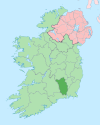Cranagh (barony)
Crannagh (Irish: Crannach, meaning 'Abounding in Trees, or Woodland'[1][5]), sometimes written Cranagh or Granagh, is a barony in the north western part of County Kilkenny, Ireland.
[5] According to O'Heerin's Topographical Poem (1420)[10] at the time of the Norman invasion the area was the territory of the clan called the Ua Caibhdheanaigh (O'Coveney, Keveny) who were the chiefs of the plain of Magh Airbh (Moy Arve) and Clar Coill.
[9][10] "Magh-Narbh", or the plain of Arbh, named for Narbh, Prince of Ireland, and the son of Úgaine Mór, comprised much of the present barony.
[5] In 1609 Sir John de Rocheford of Killary and George St. Leger of Woncestown (Bouncestown) were returned as Constables of the barony.
[9] By the 19th century these were restructured into the baronies of Callan, Crannagh, Fassadinin, Galmoy, Gowran, Ida, Iverk, Kells, Knocktopher, and Shillelogher.
[7] The baronies highest point is 349 metres (1,145 ft) at Clomantagh Hill with a sandstone rock formation resting on the central county limestone substratum.
[20][19] Crannagh is made up of 19 civil parishes including Freshford, Odagh, Ballycallan, Ballylarkin, Ballinamara, Killahy, Kilcooly, Killaloe, Kilmanagh, Clomantagh, Coolcraheen, Fertagh, Garranamanagh, Clashacrow, St. Canice, Sheffin, Tubbridbritain, Tullaroan, and Tullaghanbrogue.

